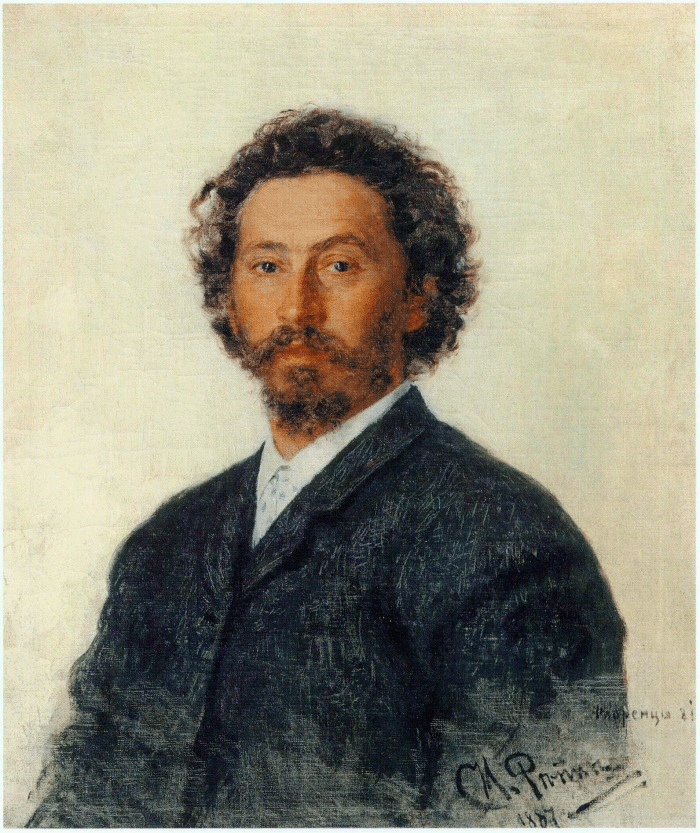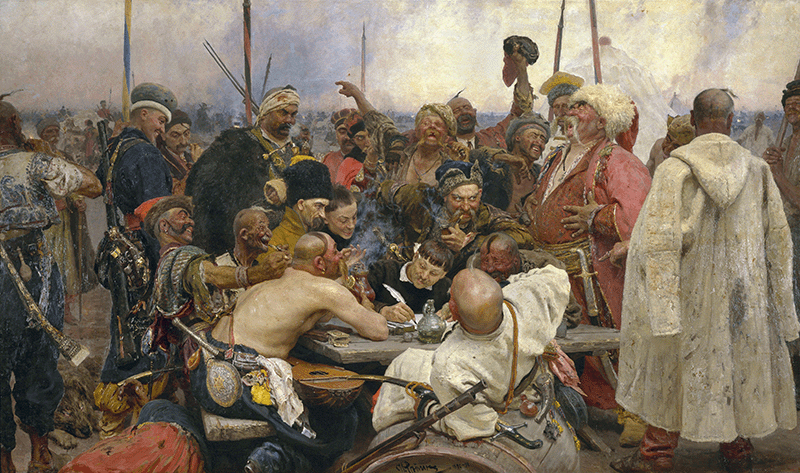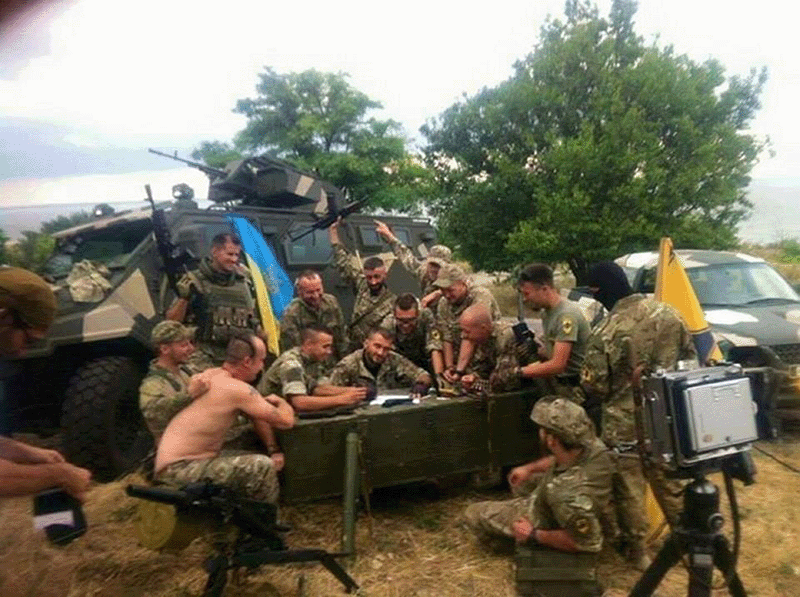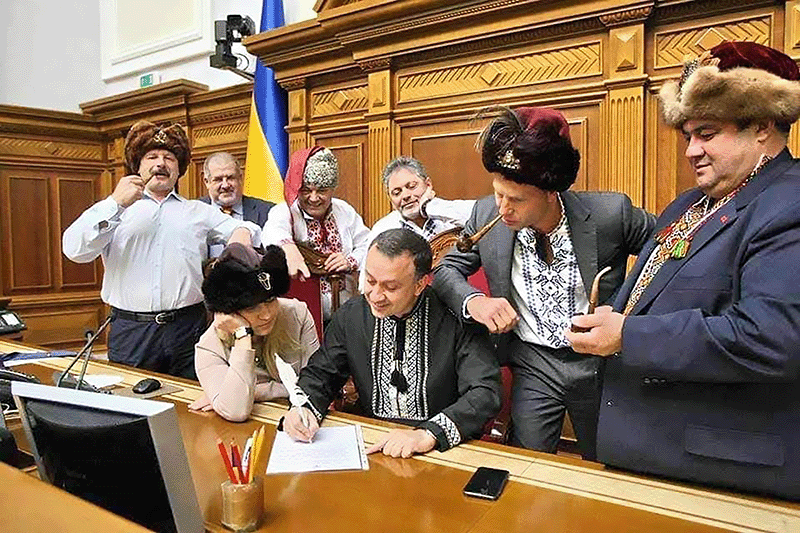- Art
- Exhibitions
- Farm to Table: Food and Identity in the Age of Impressionism
- Cycle Thru! The Art of the Bike
- Tintoretto’s Genesis
- Upcoming Exhibitions
- Online Exhibitions
- Special Features
- Past Exhibitions
- Explore the Collection
- Provenance and Cultural Property
- Conservation
- Meet the Curators
- Digital Resources
- Art Bridges Cohort Program
A painting in the collection of the Cincinnati Art Museum, and currently on view in the museum’s forecourt, opens a window onto the overlapping layers of history, culture and identity that have united and divided Ukraine and Russia over the past five centuries.
![Paul Porfiroff [Pavel Fedorovich Porfirov] (Russian, 1873–1958), The Zaporozhian Cossacks Writing a Reply to the Turkish Sultan, 1928, oil on canvas, 50 x 84 1/2 in. (127 x 214.6 cm), Cincinnati Art Museum: Gift of Mr. and Mrs. Bayard L. Kilgour, Jr., 1970.104](/media/298790/1970104_a01_ps_20220411.png)
Paul Porfiroff [Pavel Fedorovich Porfirov] (Russian, 1873–1958), The Zaporozhian Cossacks Writing a Reply to the Turkish Sultan, 1928, oil on canvas, 50 x 84 1/2 in. (127 x 214.6 cm), Cincinnati Art Museum: Gift of Mr. and Mrs. Bayard L. Kilgour, Jr., 1970.104
This painting is a copy of one of the most iconic artworks made in the Russian Empire: The Zaporozhian Cossacks Writing a Reply to the Turkish Sultan by Ilya Repin (1844–1930). The scene imagines the historical circumstances around a letter that the Zaporozhian Cossacks—a people who lived in Ukraine from the 1500s to the 1700s—purportedly wrote in 1676 to the Ottoman Sultan, Mehmed IV, who had demanded their unconditional surrender,despite having just suffered a major military loss to them. Through the variety of postures and expressions of the warriors and his exacting realism, Repin characterized the mocking text laced with vulgarity they are jovially preparing.
Paul Porfiroff studied with Repin in the early 1900s at the Imperial Academy of Arts in St. Petersburg. In the late 1920s, Porfiroff made copies of several of his renowned teacher’s paintings, possibly as part of a program to advance appreciation of Russian art in the United States in the early years of the Soviet Union. This copy is about 65% the size of the eleven-foot-wide primary version, which Repin completed in 1891.

Ilya Repin (1844–1930) was based in St. Petersburg, Russia, and nearby Kuokkala (just across what would become the Finnish border) for most of his career, but he was born and raised in the Kharkiv region of present-day Ukraine and expressed a particular affinity with the Ukrainian people throughout his life.
Alongside Leo Tolstoy and the composers of the Mighty Five, Repin was a central cultural figure in the last quarter of the 1800s in Russia. His realistic painting style and choice of socially critical subjects defined an era. Aligned with progressive liberal art collectives early in his career, Repin often highlighted the injustices of Tsarism but was also accepted as an establishment painter by 1900. He was not involved in the revolutions of 1917 or independence movements in the region.
Further complicating his legacy, Repin’s realistic style, socially responsive subject matter, and political leanings led the Soviet Communist Party to promote him as a model for the art policy of Socialist Realism from the 1930s onward.
With his dual identity—born to a Russian military family yet with deep connections to the Ukrainian culture of the region—Ilya Repin himself embodied the complexities of the region’s history.
Ilya Repin (1844–1930), Self-portrait, 1887, oil on canvas, 75.5 x 62.2 cm, Tretyakov Gallery, Moscow, acc. no. 10558

Ilya Repin (1844–1930), The Zaporozhye Cossacks Replying to the Sultan, 1880-91, oil on canvas, 203 x 358 cm, State Russian Museum, St. Petersburg, Ж-4005
Ilya Repin’s The Zaporozhye Cossacks Writing a Reply to the Turkish Sultan is among the most renowned paintings of the 1800s. The scene imagines the historical circumstances around a letter that the Zaporozhian Cossacks purportedly wrote in 1676 to the Ottoman Sultan, Mehmed IV, who had demanded their unconditional surrender, despite having just suffered a major military loss to them. Through the variety of postures and expressions of the warriors, and his exacting realism, Repin characterized the mocking text they are jovially preparing.
Repin worked on the composition intermittently across eighteen years (1878–96). He made visits to the Kharkiv region (present-day Ukraine) to study the descendants of the people he aimed to portray, and sought out collections of Cossack artifacts from the 1600s to depict. He completed hundreds of studies and two final versions of the painting. The first, measuring eleven feet wide, was completed in 1891 and later purchased by Tzar Alexander III for the highest price paid for an artwork in Russia. It is today in the State Russian Museum in St. Petersburg. Completed in 1896, the second version has been in Ukraine since 1935 and is one of the most prized works in the Kharkiv Art Museum.

Ilya Repin (1844–1930), The Zaporozhye Cossacks Replying to the Sultan, 1889-96, oil on canvas, 174 x 265 cm, Kharkiv Art Museum
Further reading
- Molly Brunson, Russian realisms : literature and painting, 1840-1890, DeKalb: Northern Illinois University Press, 2016
- Molly Brunson, “Wandering Greeks: How Repin Discovers the People,” Ab Imperio: Studies of New Imperial History and Nationalism in the Post-Soviet Space, vol. 2, 2012, pp. 83-111
- David Jackson, The Russian Vision: the Art of Ilya Repin, Schoten, Belgium: BAI, 2006
- Maureen Perrie, “Fugitive Tsars and Zaporozhian Cossacks: The Development of a Seventeenth-Century Stereotype,” Harvard Ukrainian Studies, vol. 28, No. 1/4 (2006), pp. 581-590
- Walther K. Lang, “The Legendary Cossacks: Anarchy and Nationalism in the Conceptions of Ilya Repin and Nikolai Gogol,” Nineteenth-century Art Worldwide, vol 1, Spring 2002
- Elizabeth Kridl Valkenier, Ilya Repin and the World of Russian Art, New York: Columbia University Press, 1990
- Fan Parker and Stephen Jan Parker, Russia on Canvas: Ilya Repin, University Park: Pennsylvania State University Press, 1980
Between the 1500s and the 1700s from their homelands in what is today central and eastern Ukraine, the Zaporozhian Cossacks sought to maintain their autonomy by allying at different times with the Polish-Lithuanian Commonwealth, Russian Tsardom, Crimean Khanate, and Ottoman Empire. Their reputation as a fiercely independent people emerged from a complex history of regional conflict.
Ily Repin praised the historical Cossacks for their “love of freedom and heroic spirit.” Repin’s embrace of the subject followed Nikolai Gogol’s 1835 Taras Bulba, a popular Romantic novel following the life of a Zaporozhian Cossack, and was spurred on by conversations with Leo Tolstoy, whose The Cossacks also explored the complex history and vibrant spirit of the southern regions of the Russian Empire.
Repin’s The Zaporozhian Cossacks has had a broad reach and deep resonance in Russia and Ukraine. The first version was endorsed by the Tzar, who purchased it for the imperial collection; the second version has been a treasured highlight of the art museum in Kharkiv for almost a century. The image was promoted within the Soviet Union and abroad throughout the twentieth century. A cultural touchstone, and it has been beloved by generations of Ukrainians and Russians alike.
The image is capable of evoking many confrontations—Christian versus Muslim; freedom versus subjugation; wit versus imperiousness. In recent years, amidst the tragedies of war, it has emerged as a potent symbol of cultural identity the struggle for Ukrainian sovereignty.

Ukrainian soldiers recreating the painting early in the Donbas war following the 2014 Maidan Revolution in Ukraine and Russia’s annexation of Crimea, August 2015 (source)

Ukrainian members of Parliament recreating the painting as they pen a response to Vladimir Putin’s essay “Historical Unity of Russians and Ukrainians,” July 2021 (source)
Cincinnati and Kharkiv have been connected for over thirty years through the Cincinnati-Kharkiv Sister City Partnership. In that time, personal, professional and artistic relationships between Kharkivians and Cincinnatians have flourished. The attention and sympathies of many Cincinnatians are focused on Kharkiv as the horrors of war visit Ukraine.
The Kharkiv Museum of Art damaged by Russian shelling
- Reuters article
- Newsweek article, with video of damaged museum
- DW article, with longer video
Personal accounts from Kharkiv in the early days of the war
Text message exchanges between Kharkivians and Cincinnatian Bob Herring, President of the Kharkiv-Cincinnati Sister City Partnership.
February 24, 2022
At about 5 a.m. I heard sounds of war. Explosion. But not near. Somewhere at the edge of the city. I did not know what to think and what to do. I decided to wait and checked FB for information. Didn’t find any. Later some info started to come and in about two hours I knew that Russia had attacked our military infrastructure and attacked the boarder. From Belarus also.
Lots of people try to move out of the city.
People try to store some food and water. Take money from banks.
We (I mean my wife and me) are trying to stay calm and get proven information of what is actually going on.
No panic on the streets. No tanks yet.
Army is fighting.
We need, I think, some international help. Now. Sanctions. Armor. Demonstrations at Russian embassies. I don’t know.
Putin has threatened the whole world not to interfere, but if the world stays aside, Putin will come to it too.
Andrew
--
Dear Bob! Dear American friends!
The situation is really quite scary. We were woken up by several explosions next to Kharkiv at 5 AM. We were told that the Russian troops started shelling the military infrastructure in our region and all other regions, bordering with Russia and Belarus.
The missile attacks are done all over Ukraine, aiming, first of all, military stock houses, airports, and air defense.
My colleagues and friends from different regions reported Russian troops and heavy military vehicles (including tanks) to cross the borderline. Some of the settlements are already seized.
It's a full-scale invasion by bloody Russians. My family and I are still in Kharkiv fully ready to leave once we have such an opportunity. For the time being, the roads from Kharkiv are blocked by a big number of those who are leaving the city. For nowhere... Cause I still do not have a clear understanding of where to go from here now.
But we do not panic. We need some time to learn the plans of the invaders.
I'll keep you updated.
Iryna
--
Hi Bob
Woken up by blasts at 5 am. Now the Russkies are 5 km away. V could hear Kalashnikovs working when he went to pick up his mother-in-law. There was pinpoint bombing or shelling of some military objects in Kharkiv. We had to queue for fuel for an hour.
The Mayor is working hard to control the situation. Schools and kindergartens are closed. Vitally important services and factories are working as usual. Kharkiv air shelters with a capacity of 1.5 are in adequate condition. Banks, shops, public transport, water, heating, electricity OK with fighting just 5km away! The Mayor is always in contact with people visiting major sites, meeting people, giving press conferences
Iryna
February 27, 2022
We are hanging in there. Everything that is happening is not OK at all but we have no choice but to survive. That's all we do - me and A in the subway. This night we slept in the carriage of subway with lots of other people. It is like you are on the train and it is your destination but you shouldn't go home as it is not safe.
A decided to stay home and learn to recognize sounds to match them to the weapon. We keep in touch, text to each other. I don't understand how it finishes. It has been three hellish days and I want it to be over but I don't see how. What is the resolution? I see now the whole world is against Putin but it doesn't look that it helps. These are rhetorical questions and I wish I knew the answers to them.
Thanks for your support, our message. It is good to get a massage when I get a connection. We are hanging in there. It is not getting better. It is very dangerous inKharkiv, shooting in the street. Our city is getting ready to fight the Russians inside the city. There still attacking
Natalie
--
Hi Bob
It’s been the hardest 36 hours with heavy bombing and shelling and then they tried to penetrate the city. Street fighting was everywhere, now coming to an end. Our troops and civil defense militia are sweeping the few streets where you can still see the horde. Many houses were destroyed, old people, women and children killed. You can see unexploded shells and missiles near kindergartens and schools and on street playgrounds and stadiums. Barbarians. We receive dozens of communications from Russia from distant relatives and people we haven’t seen or heard of for many years. They express their support and solidarity. Many have contributed to the Ukrainian Armed Forces account. They are all ashamed and angry. Many have gone on peace pickets and marches.
Love to all your family and those who know us,
Victor
March 1, 2022
Morning in Ukraine. We are alive!!
Ukraine is changing the world - it is so moving. We are all crying, we know that our freedom costs the lives of so many people. We are proud of our men standing for the whole world. I am writing to you and crying. Thanks for your support. It is priceless.
Iryna
--
We are in the subway. We don't come out. We are OK. A was at home while they were bombing the center. It was 50 meters from our block of flats. We have holes in the windows and in the roof as it is on the top floor. A is OK but full of rage.... We are thinking of going away from Kharkiv by train but there are a lot of buts ....Everyday we hope for better news, but each day is worse than the day before.
Nadia
March 2, 2022
I am not good today. I think I have had enough. Tomorrow we will get to the train station and will try to go away somewhere. I wish I had better news but it gets worse and worse. The whole center of the city is ruined
[Bob: Where will you go?]
Anywhere by a train which we will be able to get on. It can be Lviv, Ternopil or some other places where it is quiet.
Nadia
--
Very sad news. they bombed Svoboda Square, the heart of the city. Some people were killed. They are destroying our beautiful city which we have been building with such love and care. There was an explosion near our City Hall. Hope people are alive.
Iryna
March 3, 2022
We woke up at 4:a.m. and went through the tunnels to the train station. At 6:30 there were many people at the station. A is staging in Kharkiv.
We got on the train to Khmelnitsky. We got so lucky and are very happy to leave Kharkiv. We are dreaming of a shower and a soft bed. I hope to arrive at our destination by tomorrow morning, but nobody knows for sure. I think we well need 2 days to relax and understand what to do next. I don't think we will stay there. We want to go further from Kyiv, maybe Chrnivtsy, Uzhhorod is the best choice.
This trip is not an easy one as we have to spend 20-24 hours in a sitting position in a crowded compartment (of the train) - so we won't' feel good tomorrow, but we are not going to be bombed, hopefully. Do you understand this war? Do you have any idea how long it is going to be?
Nadia
March 4, 2022
We managed to leave Kharkiv-Valeriy, P and grandchildren are still in Kharkiv, helping people in Kharkiv. We are praying that they can leave the city and they will find petrol (it is the toughest problem) They have smashed the city, people are dying in their houses.
We can watch Russian news here. They lie every moment, they tell their people that they destroy military objects and kill nationalists. They say that they don’t hurt common people. My relatives from Moscow wrote to me that they are forbidden to transfer any news from Ukraine (15 years imprisonment)
All trains from Kharkiv are packed, many people choose Lviv as then there will be a chance to leave Ukraine.
Bob, thanks a lot for so many years of our great friendship, light and happiness. I hope that our Ukrainian nation will survive, as they want to destroy us. People of Kharkiv are ready to stand for Kharkiv and Ukraine till the every end. Long live Ukraine Pray for our beautiful country and our people
Iryna
March 5, 2022
Kharkiv is still holding. Downtown is badly damaged. Not one single intact neighborhood. We hear cannonade, artillery shelling and planes all the time. One village near our dacha is razed to the ground. But in spirit the Ukrainian people are undefeated.
Sasha
--
Hi from Poltava Region. Safe and sound. We are together with V family. P and family have stopped in Dnipro. The tragedy of Kharkiv continues. They destroyed 40 houses yesterday! Apartments, not military facilities. Today the Russians turned one of the Karazin University’s sports centers into ruin. There is shortage of food and medicines. But people are working miracles of spirit and devotion. We desperately need air defense because we are not able to put an end to air raids of those barbarians. However, dum spiro, spero. Hi and thanks from Iryna! No Internet. Just appears for a few seconds just enough to send our messages
Iryna






